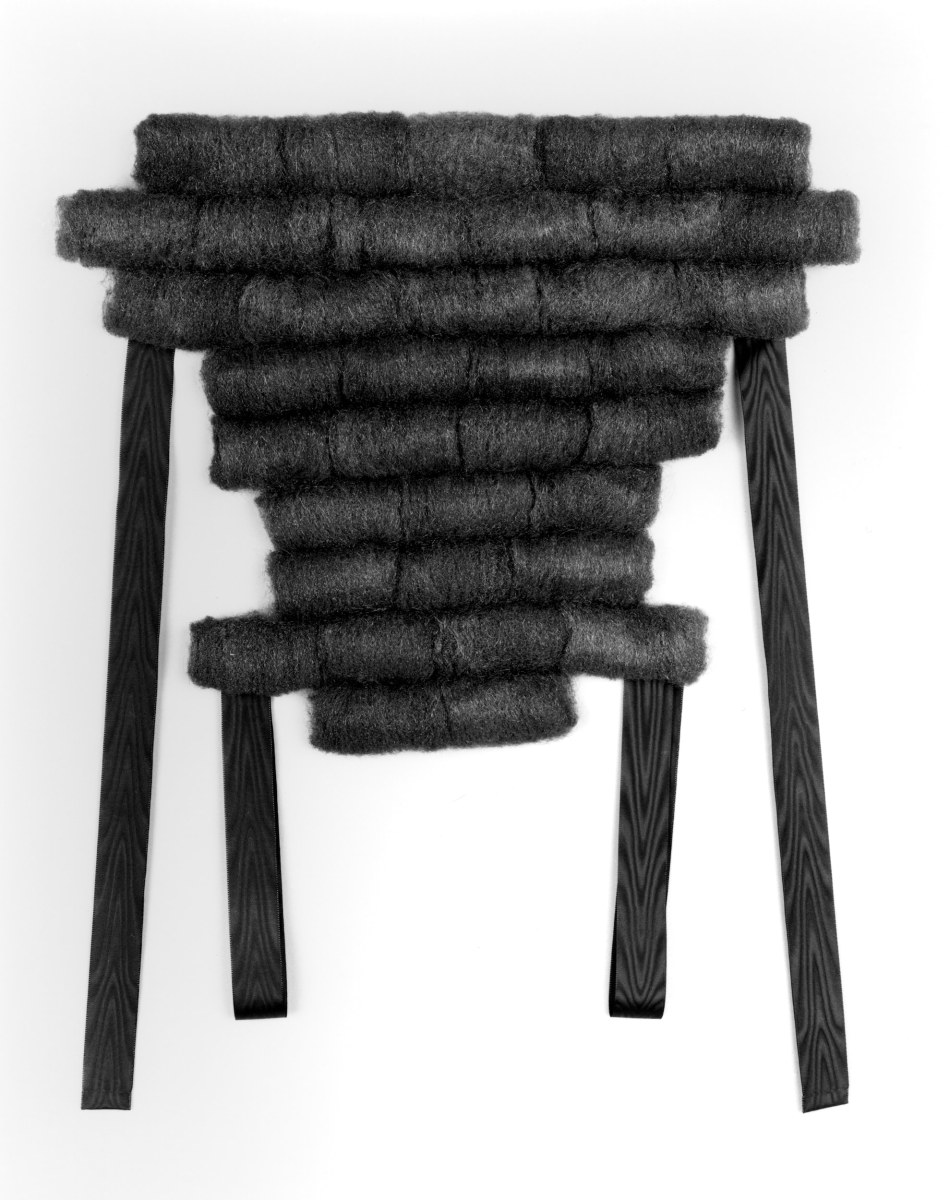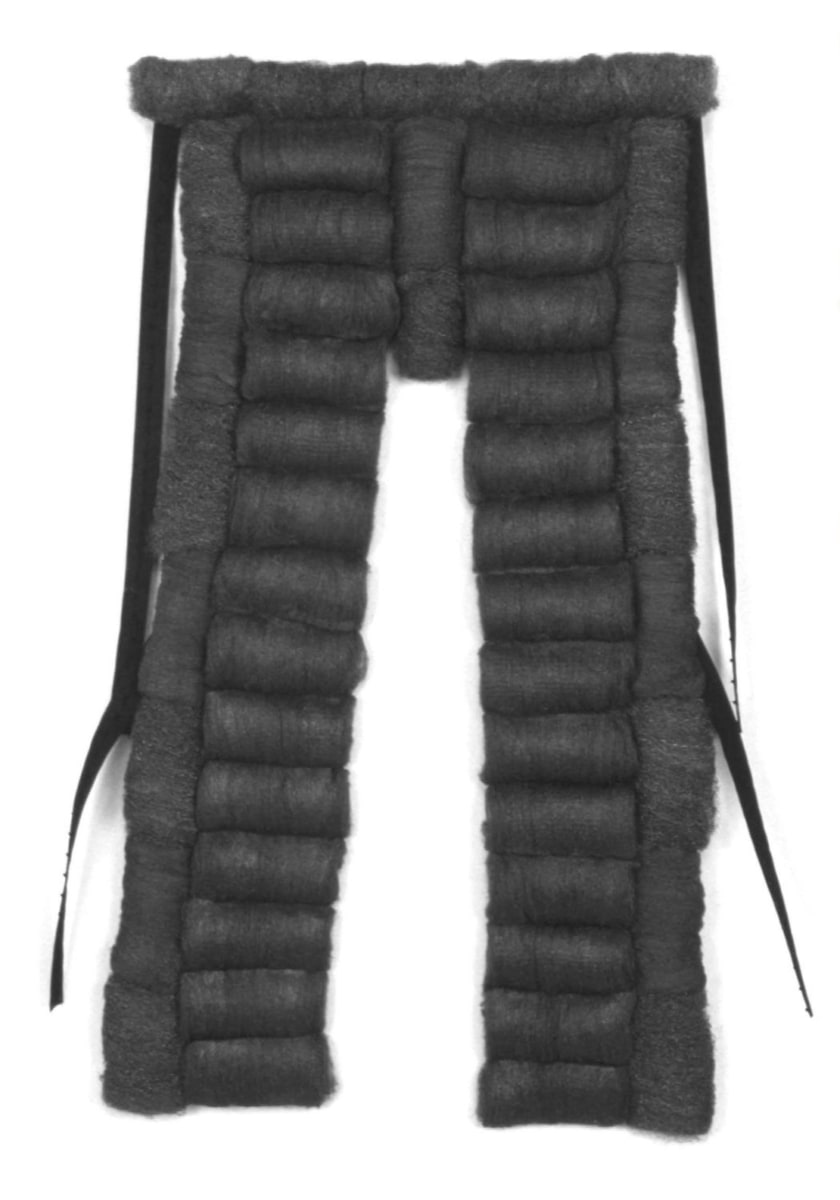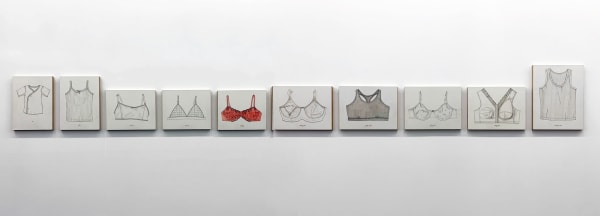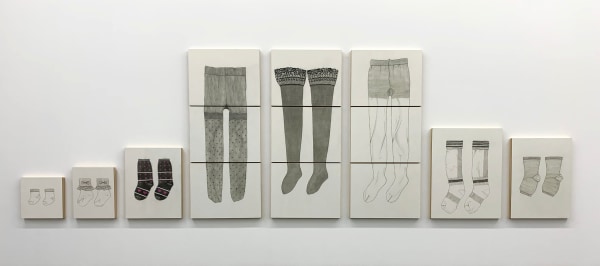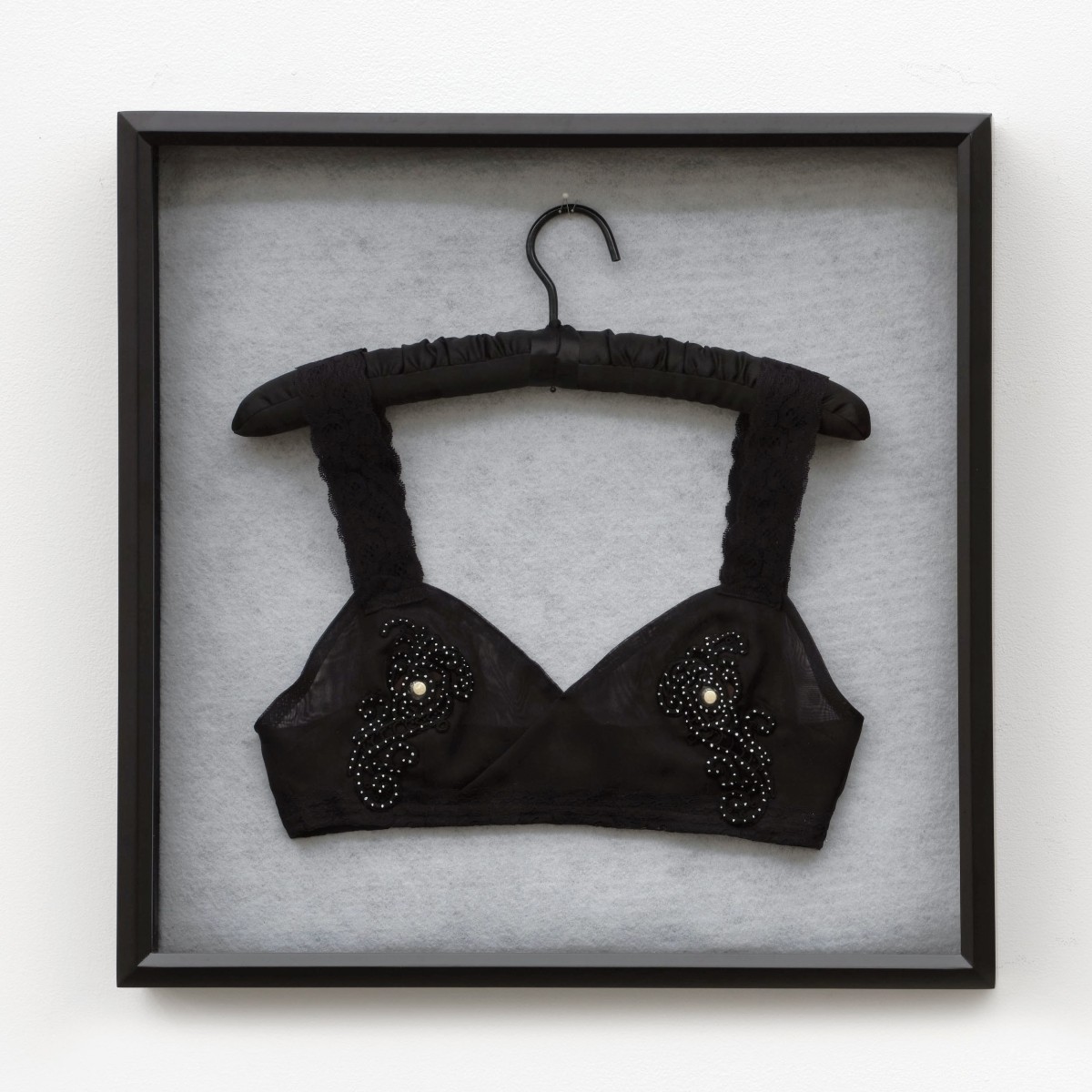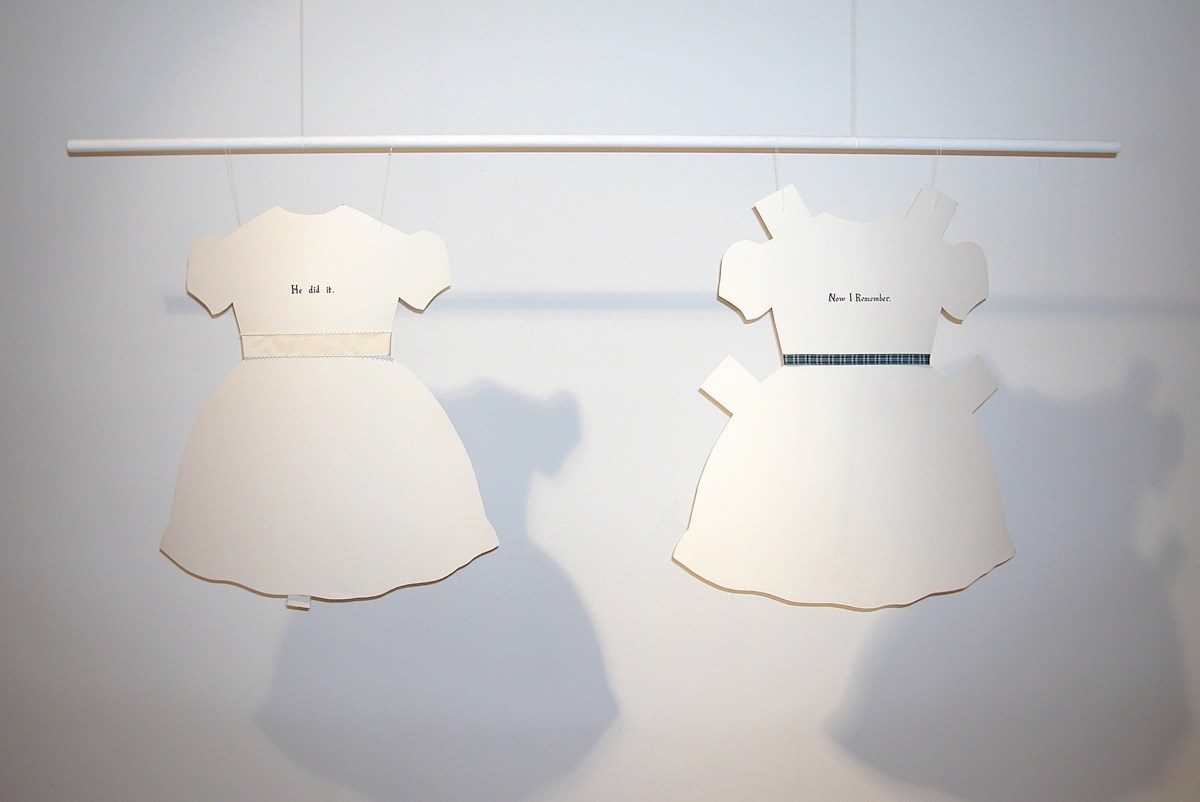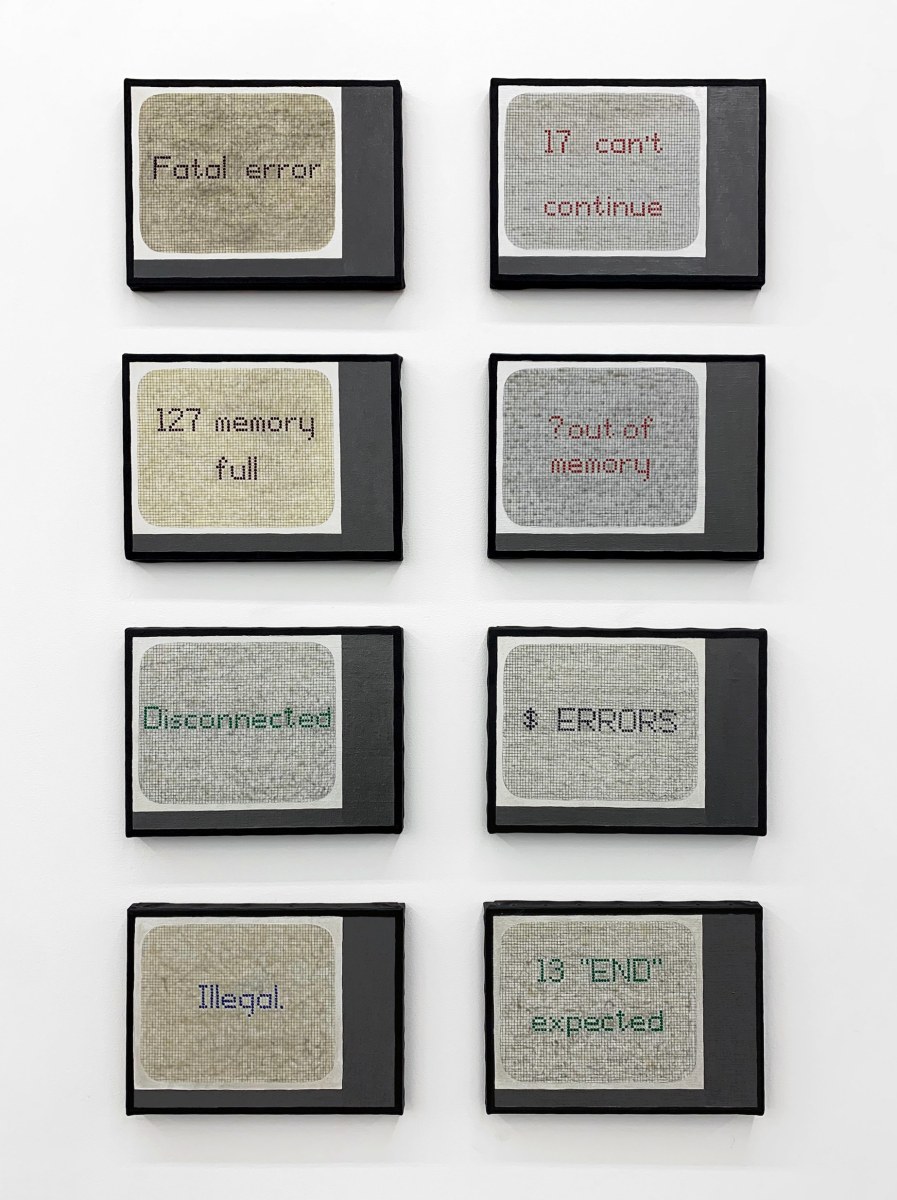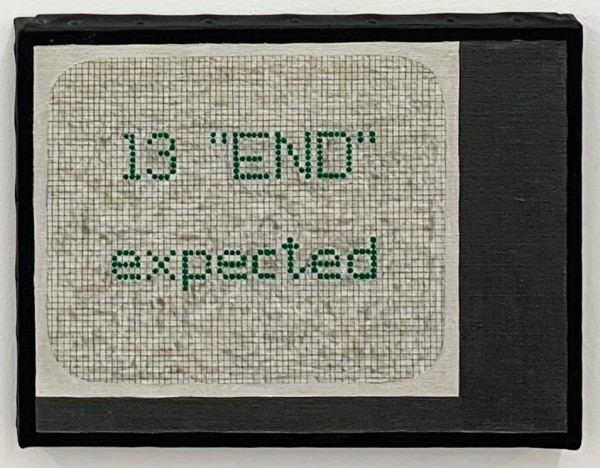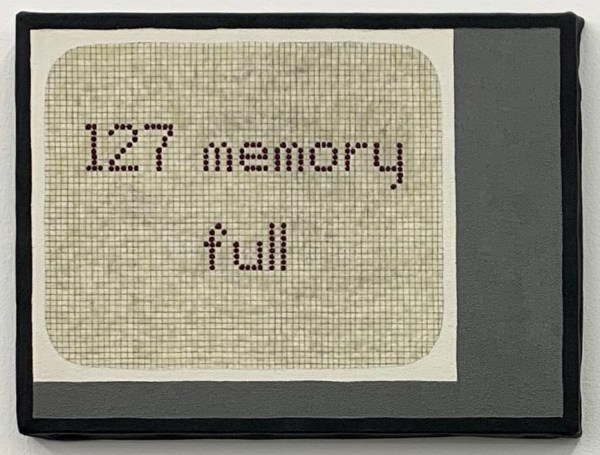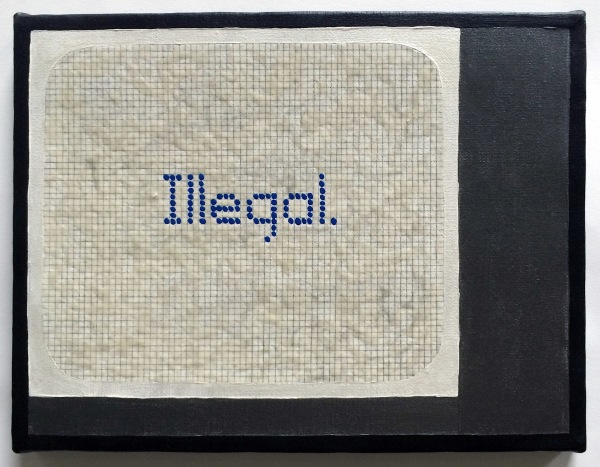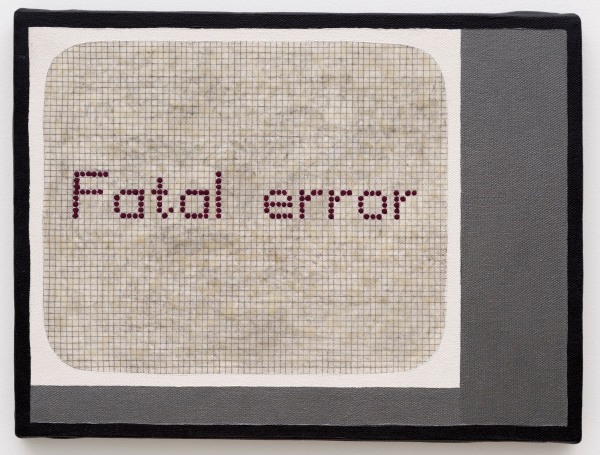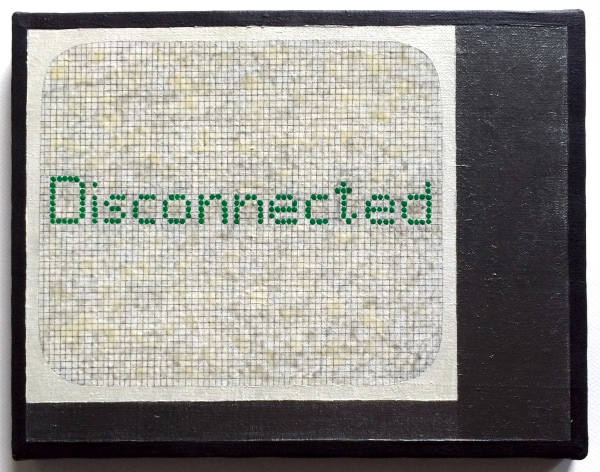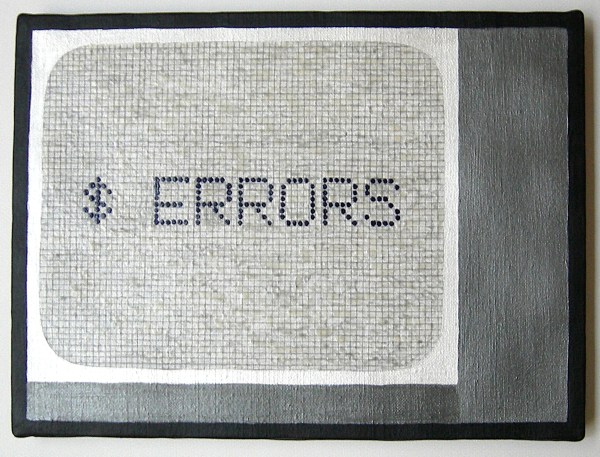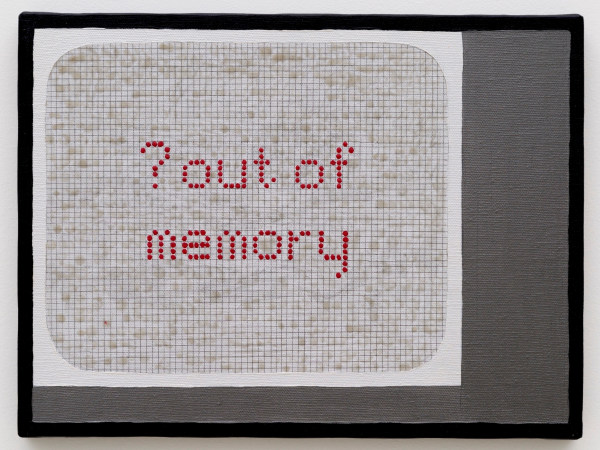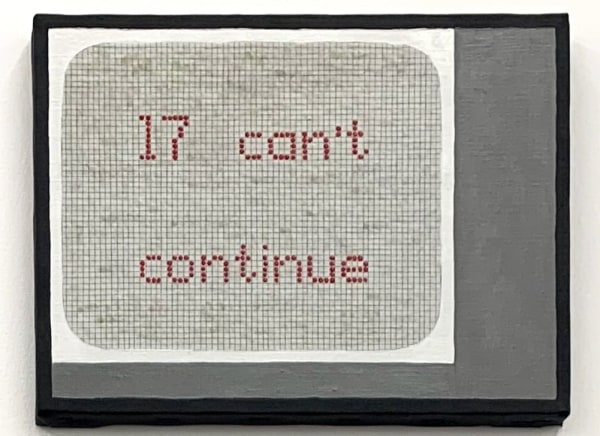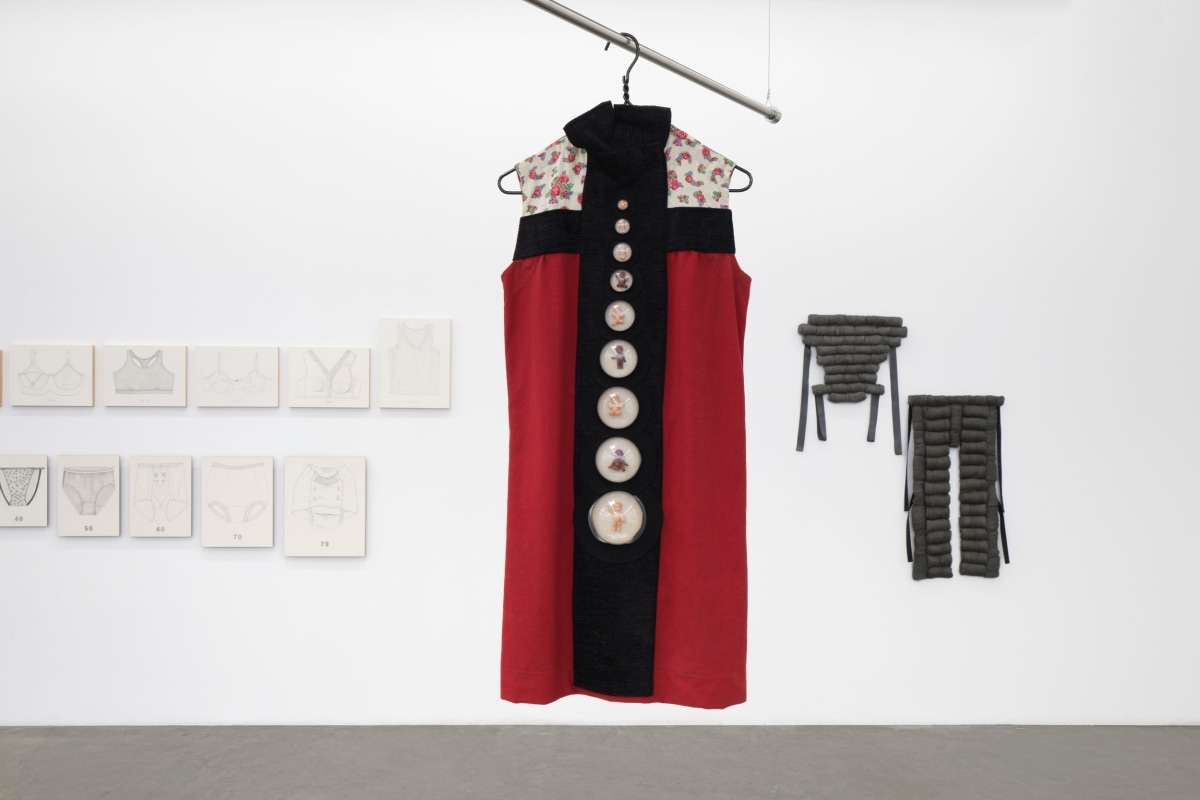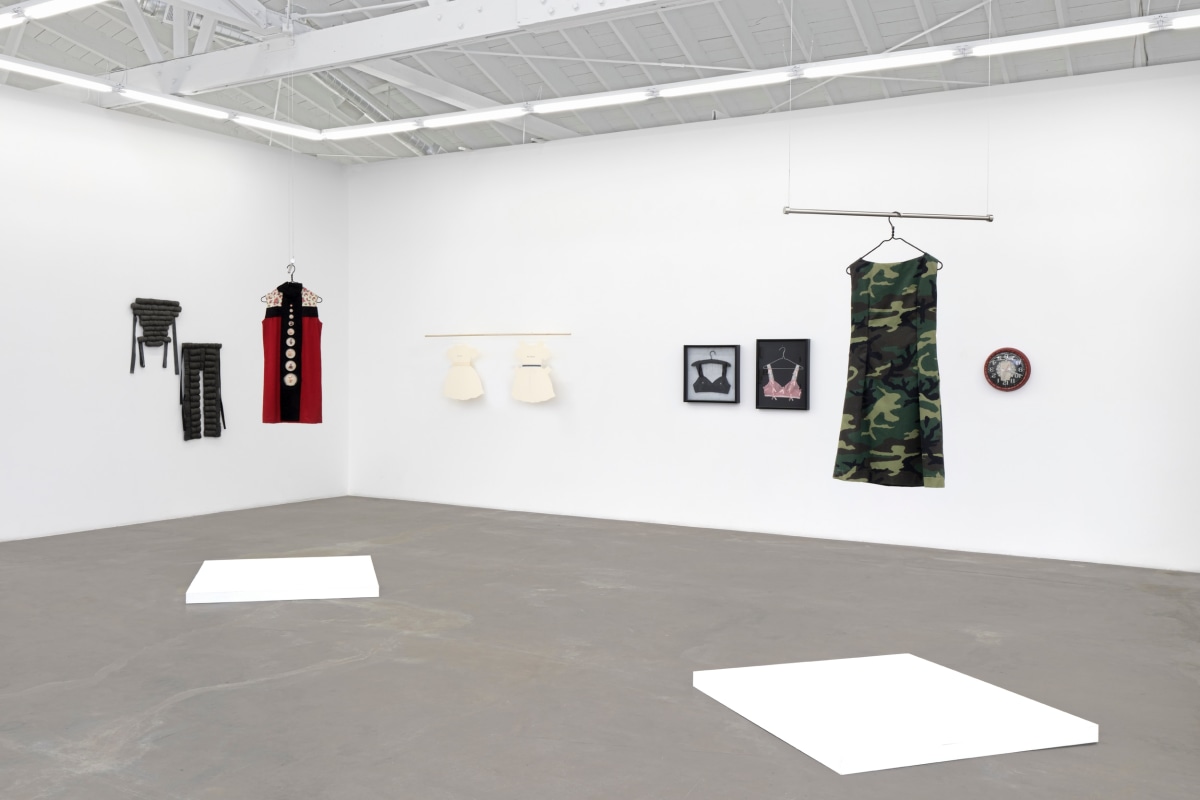
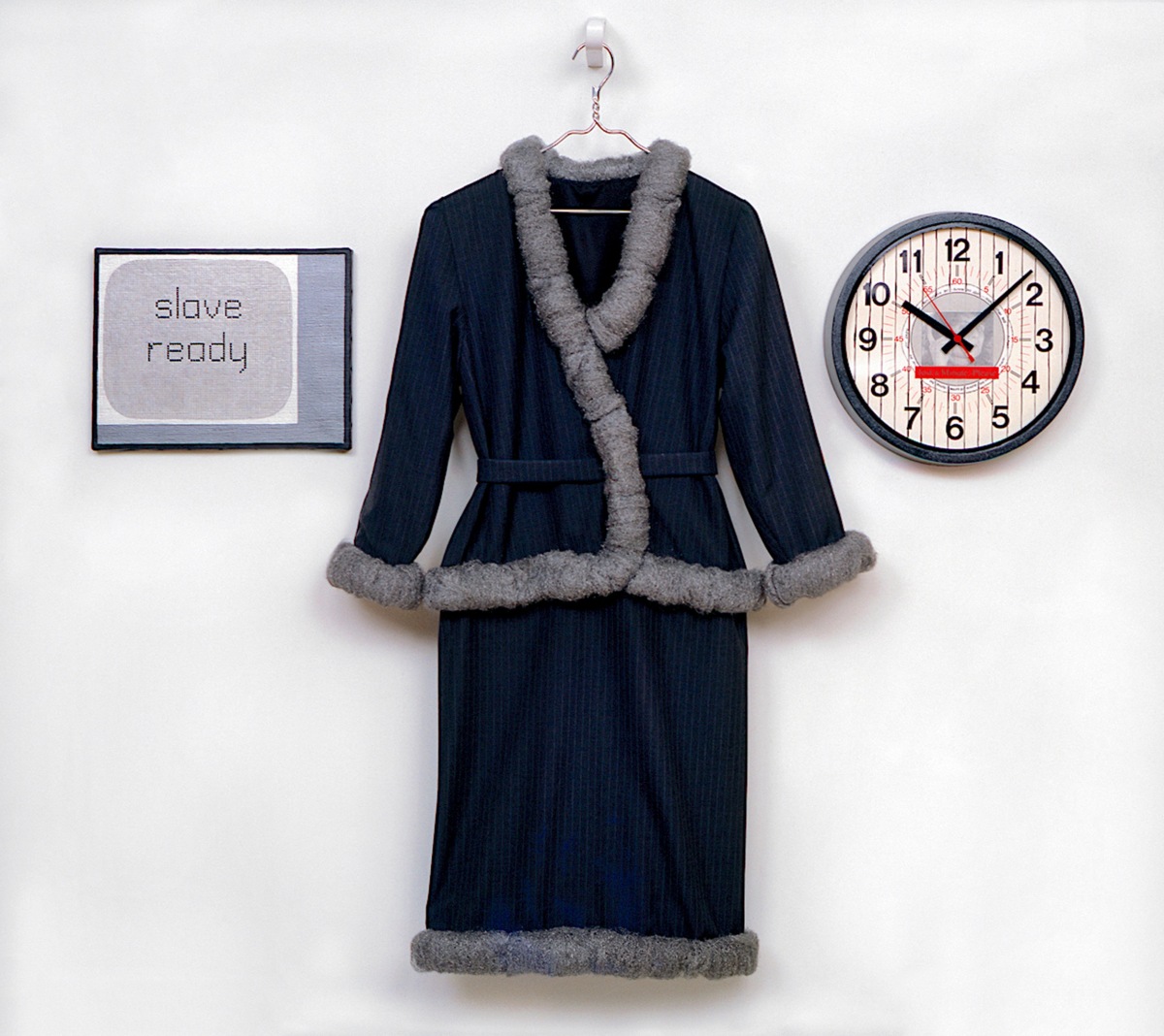
Mimi Smith
Slave Ready: Corporate, 1991-1993
Suit: steel wool, pinstripe fabric, aluminum hanger; painting: acrylic and pencil on canvas; clock: acrylic and computer prints on clock
50 x 60 x 6 in (127 x 152.4 x 15.2 cm)

Mimi Smith
Don't Turn Back, 1985
Acrylic, paper and Xerox on clock
14 x 14 x 2 in (35.6 x 35.6 x 5.1 cm)
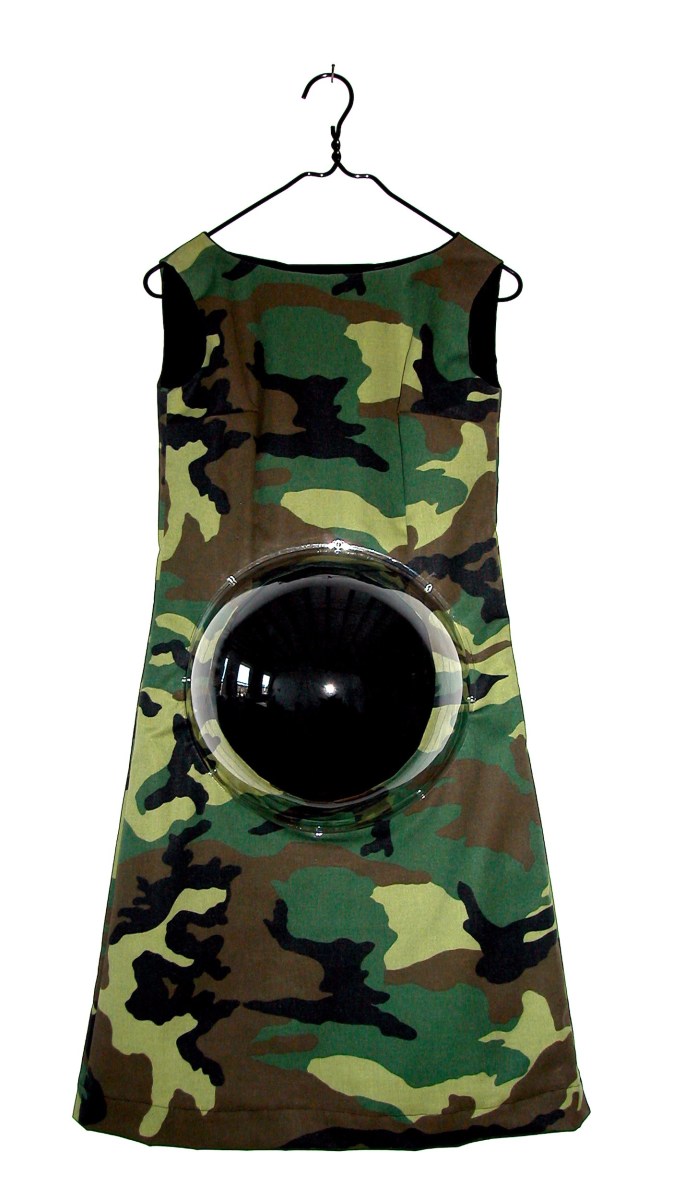
Mimi Smith
Camouflage Maternity Dress, 2004
Fabric, plastic dome, screws, and hanger
47 x 22 x 9 in (119.4 x 59.9 x 22.9 cm)
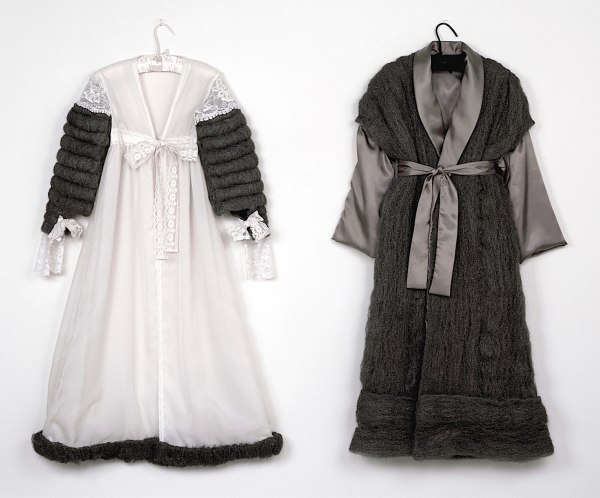
Mimi Smith
Biography, 1996
Steel wool, nylon, lace and satin hangers
56 x 72 x 7 in (142.2 x 182.9 x 17.8 cm)
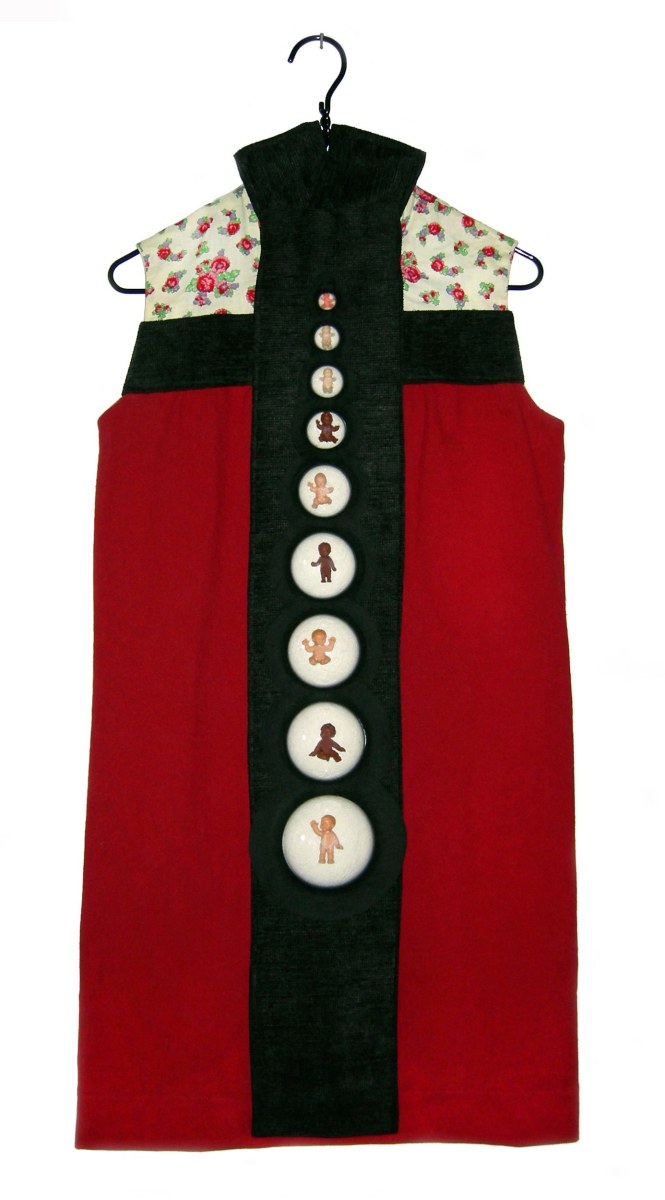
Mimi Smith
Nonuplets, 2010
Fabric, plastic domes, dolls, and hanger
43 x 20 x 5 in (109.2 x 50.8 x 12.7 cm)
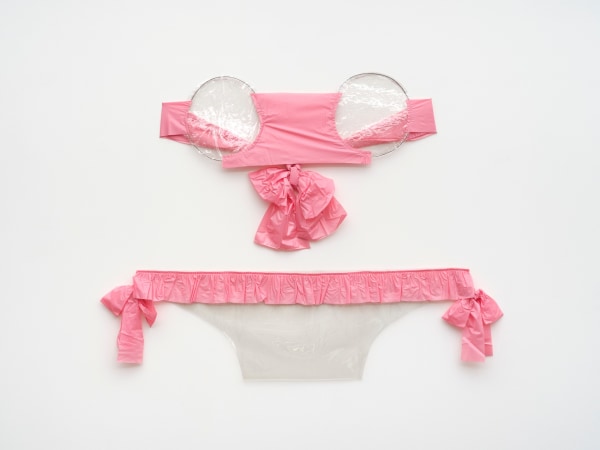
Mimi Smith
Bikini, 1965 (recreated 1993)
Plastic, wire
48 x 48 in (121.9 x 121.9 cm)
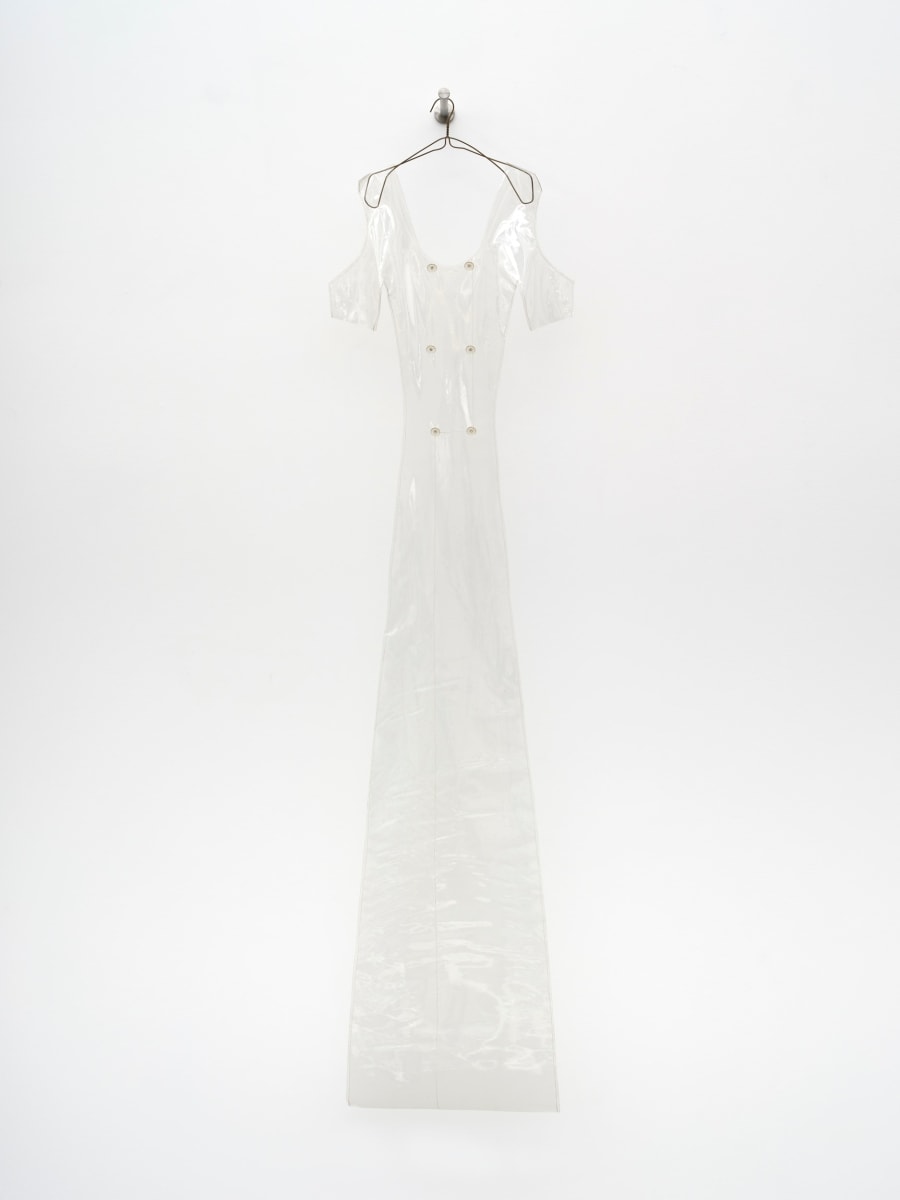
Mimi Smith
Model Dress, 1965 (recreated 1993)
Plastic, buttons and metal hanger
72 x 18 in (182.9 x 45.7 cm)

Mimi Smith
Recycle Coat, 1965 (recreated 1993)
Plastic, plastic bags, bottle caps, metal hanger
50 x 34 in (127 x 86.4 cm)
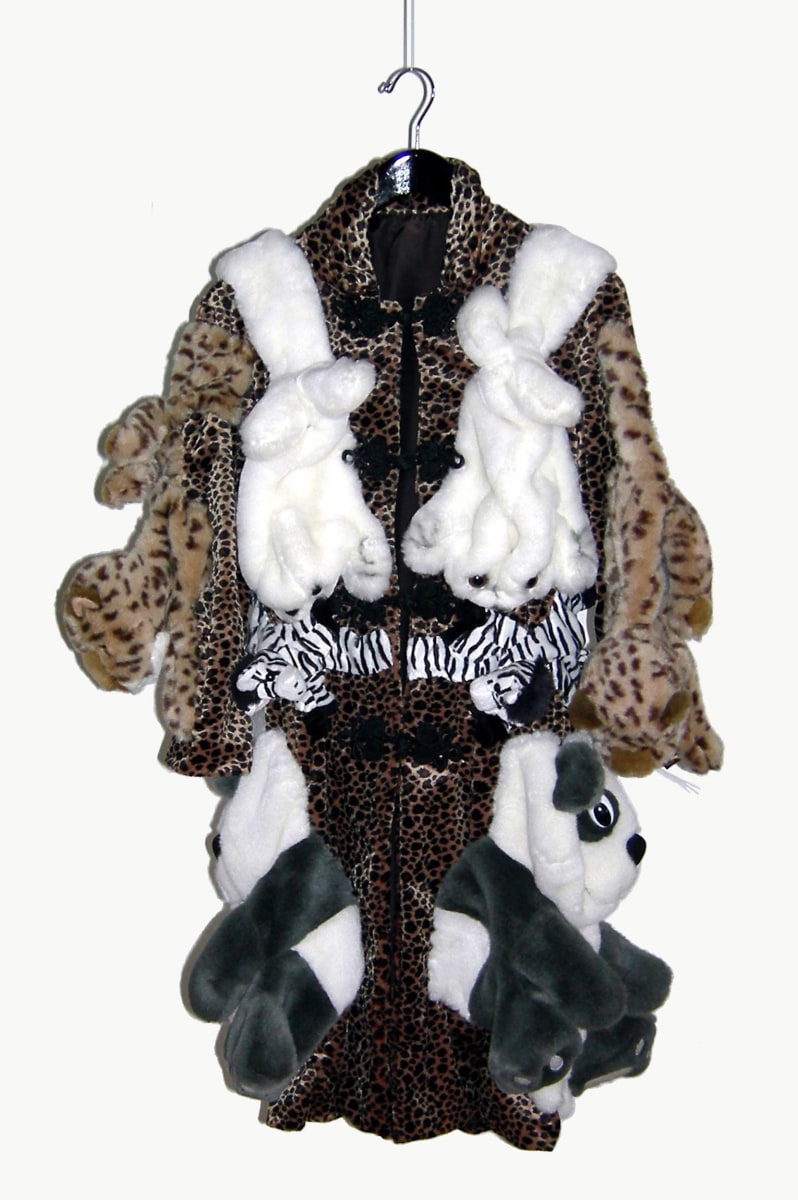
Mimi Smith
Endangered Species Coat (front), 2007
Fabrics, stuffed animals and hanger
46 x 29 x 11 in (116.8 x 73.7 x 27.9 cm)
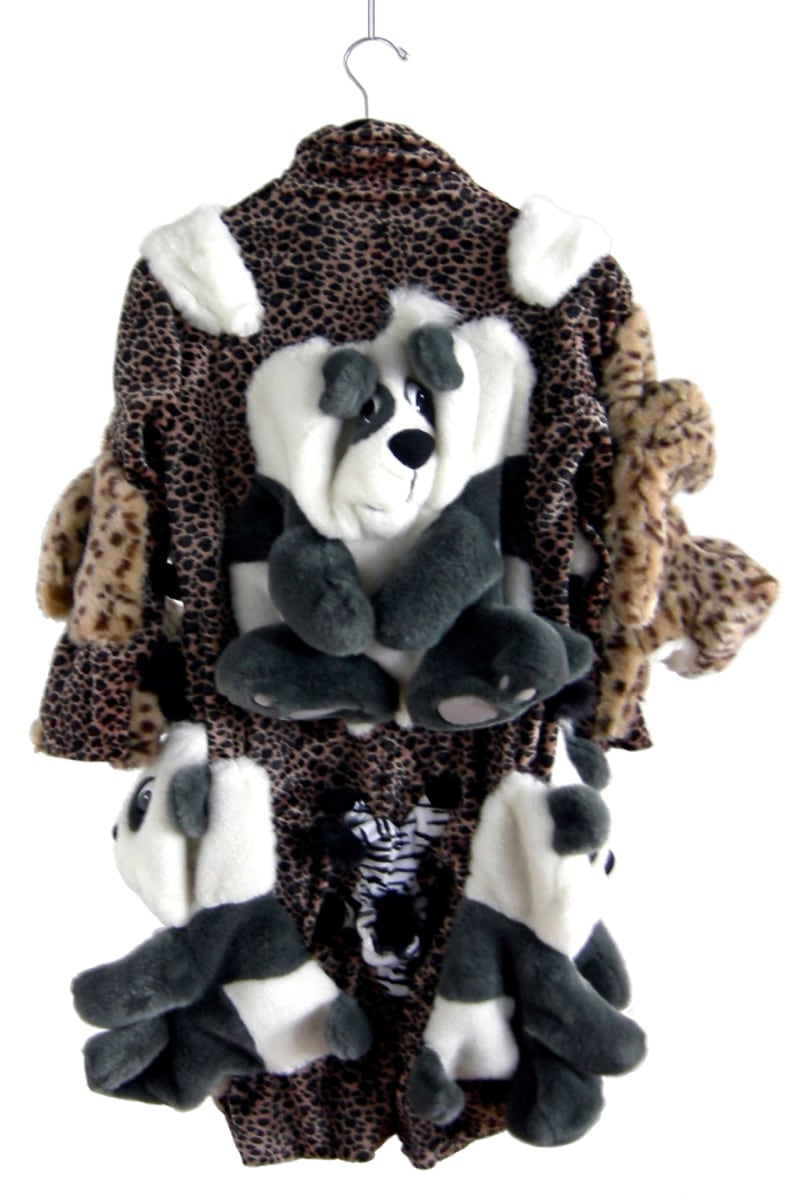
Mimi Smith
Endangered Species Coat (back), 2007
Fabrics, stuffed animals and hanger
46 x 29 x 11 in (116.8 x 73.7 x 27.9 cm)
Mimi Smith
Coverings for an Environmental Catastrophe: Chest Plate, 1991
Steel wool, aluminum screening, hooks
30 x 24 x 2 in (76.2 x 61 x 5.1 cm)
Mimi Smith
Coverings for an Environmental Catastrophe: Chaps, 1992
Steel wool, aluminum screening, hooks
38 x 26 x 3 in (96.5 x 66 x 7.6 cm)
Mimi Smith
Timelines: Undershirts, 2005
Acrylic, watercolor and graphite on board
18 x 160 in (45.7 x 406.4 cm)
Mimi Smith
Timelines: Underpants, 2002
Acrylic, watercolor and graphite on board
20 x 109 in (50.8 x 276.9 cm)
Mimi Smith
Timelines: Socks, 2014
Acrylic and graphite on board
109 x 33.25 in (276.9 x 84.5 cm)
Mimi Smith
Timelines: Shoes, 2000
Acrylic and graphite on board
20 x 143 in (50.8 x 363.2 cm)
Mimi Smith
Protector Against Illness: Black Tamoxifen Bra, 1996
Nylon, lace, tamoxifen pills, acrylic paint, and satin hanger
21.25 x 21.25 x 3 in (54 x 54 x 7.6 cm)
Mimi Smith
Protector Against Illness: Bra, 1993-1997
Fabric, ribbon, lace and metal hanger
25 x 19 x 2.75 in (63.5 x 48.3 x 7 cm)
Mimi Smith
Paper Dolls, 1995
Paper, ink, ribbon and thread, hung from dowel
25 x 22 in. each
48 x 72 inches overall
Mimi Smith
System Error Series,1988-1989
Acrylic and graphite on canvas
9 x 12 in (22.9 x 30.5 cm)
Mimi Smith
System Error 13: 13 "END" expected, 1986-1987
From the Error Messages series
Acrylic and graphite on canvas
9 x 12 x 1 in (22.9 x 30.5 x 2.5 cm)
Mimi Smith
System Error 17: 127 memory full, 1988-1989
From the Error Messages series
Acrylic and graphite on canvas
9 x 12 x 1 in (22.9 x 30.5 x 2.5 cm)
Mimi Smith
System Error 28: Illegal, 1988-1989
From the Error Messages series
Acrylic and graphite on canvas
9 x 12 in (22.9 x 30.5 cm)
Mimi Smith
System Error 16: Fatal error, 1988-1989
From the Error Messages series
Acrylic and graphite on canvas
9 x 12 in (22.9 x 30.5 cm)
Mimi Smith
System Error 11: Disconnected, 1986-1987
From the Error Messages series
Acrylic and graphite on canvas
9 x 12 in (22.9 x 30.5 cm)
Mimi Smith
System Error 10: $ ERRORS, 1986-1987
From the Error Messages series
Acrylic and graphite on canvas
9 x 12 in (22.9 x 30.5 cm)
Mimi Smith
System Error 5: ? out of memory, 1986-1987
From the Error Messages series
Acrylic and graphite on canvas
9 x 12 in (22.9 x 30.5 cm)
Mimi Smith
System Error 3: 17 can't continue, 1986-1987
From the Error Messages series
Acrylic and graphite on canvas
9 x 12 in (22.9 x 30.5 cm)
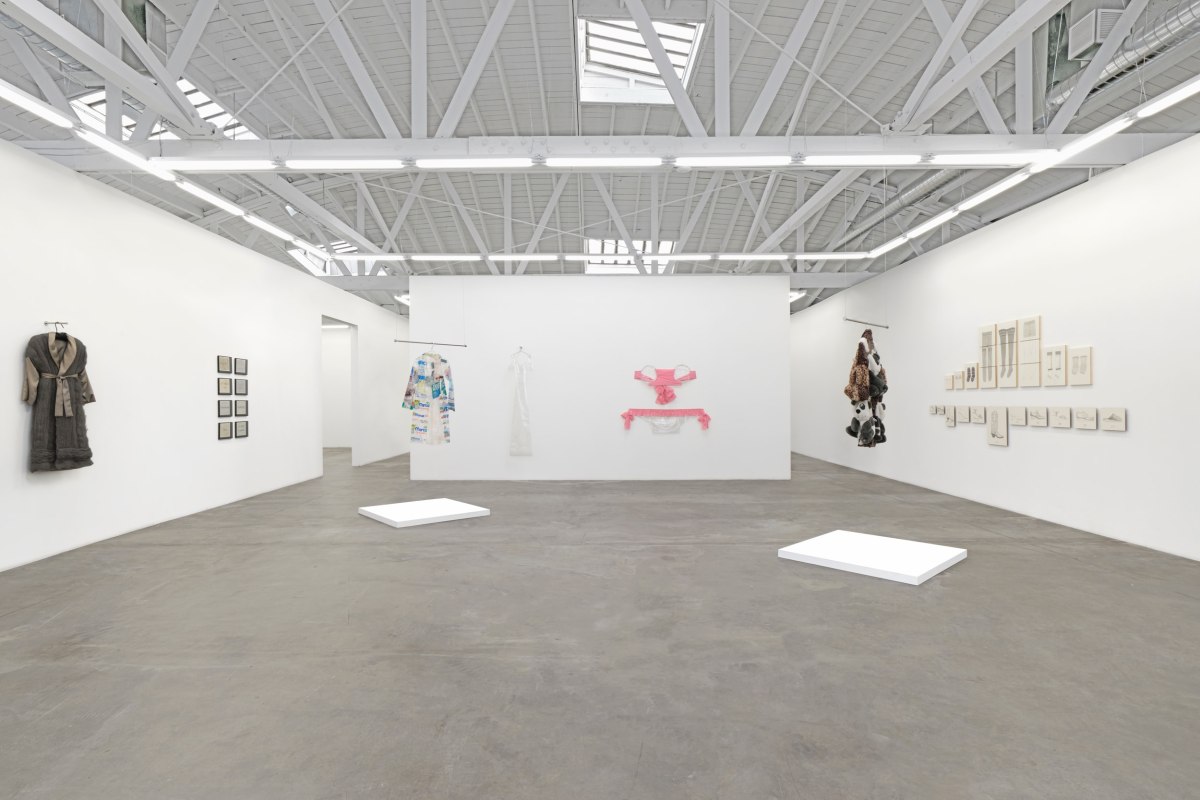
Installation view of Mimi Smith, Head-On
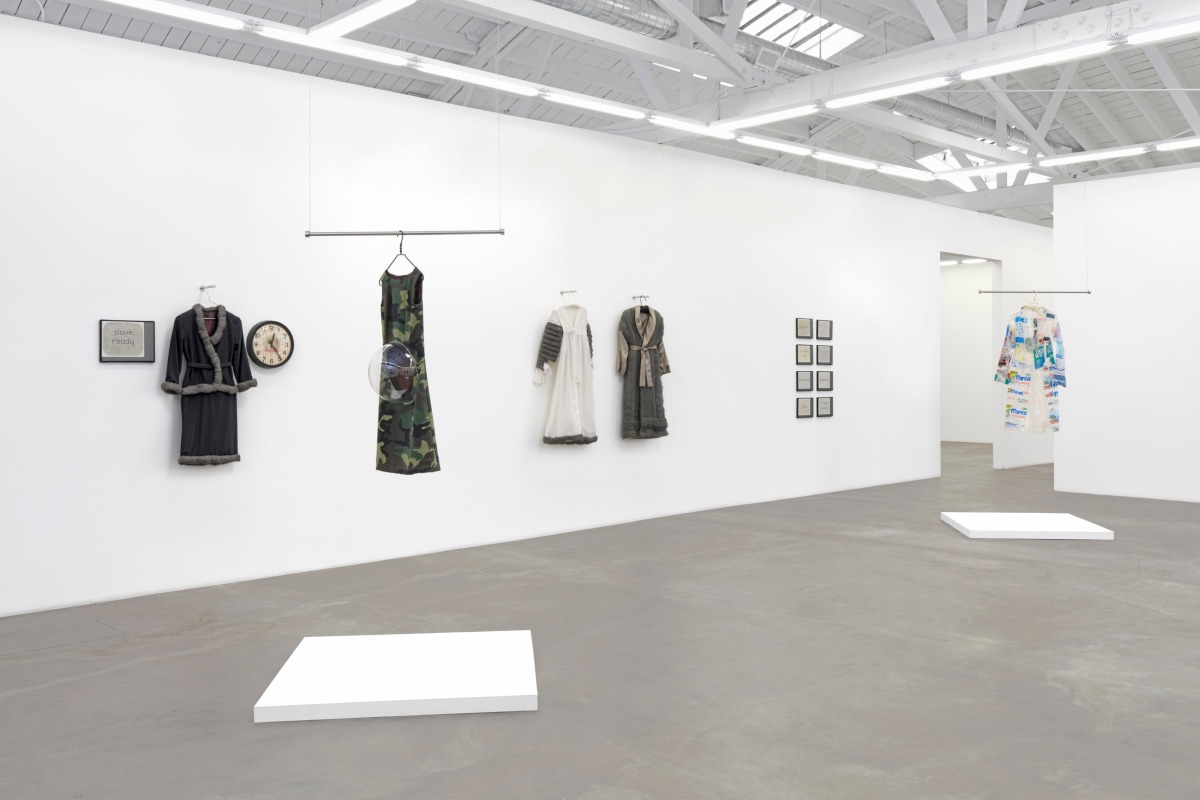
Installation view of Mimi Smith, Head-On
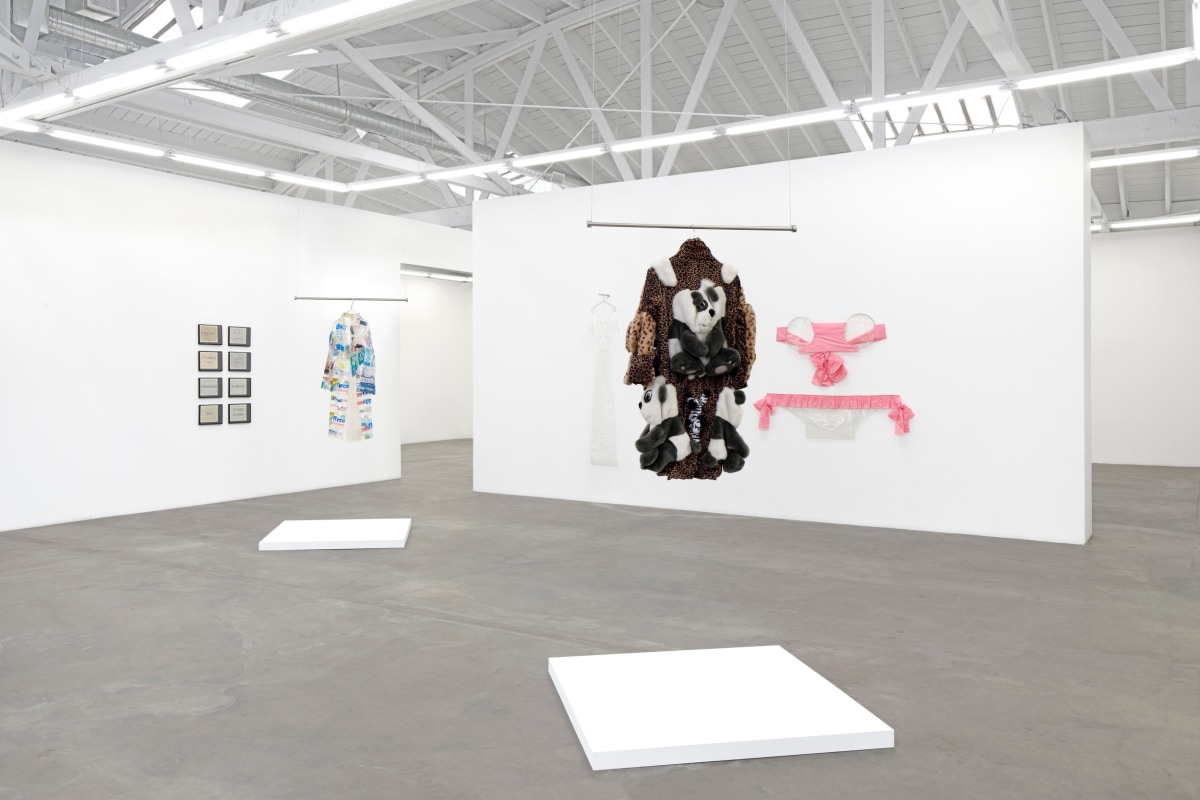
Installation view of Mimi Smith, Head-On
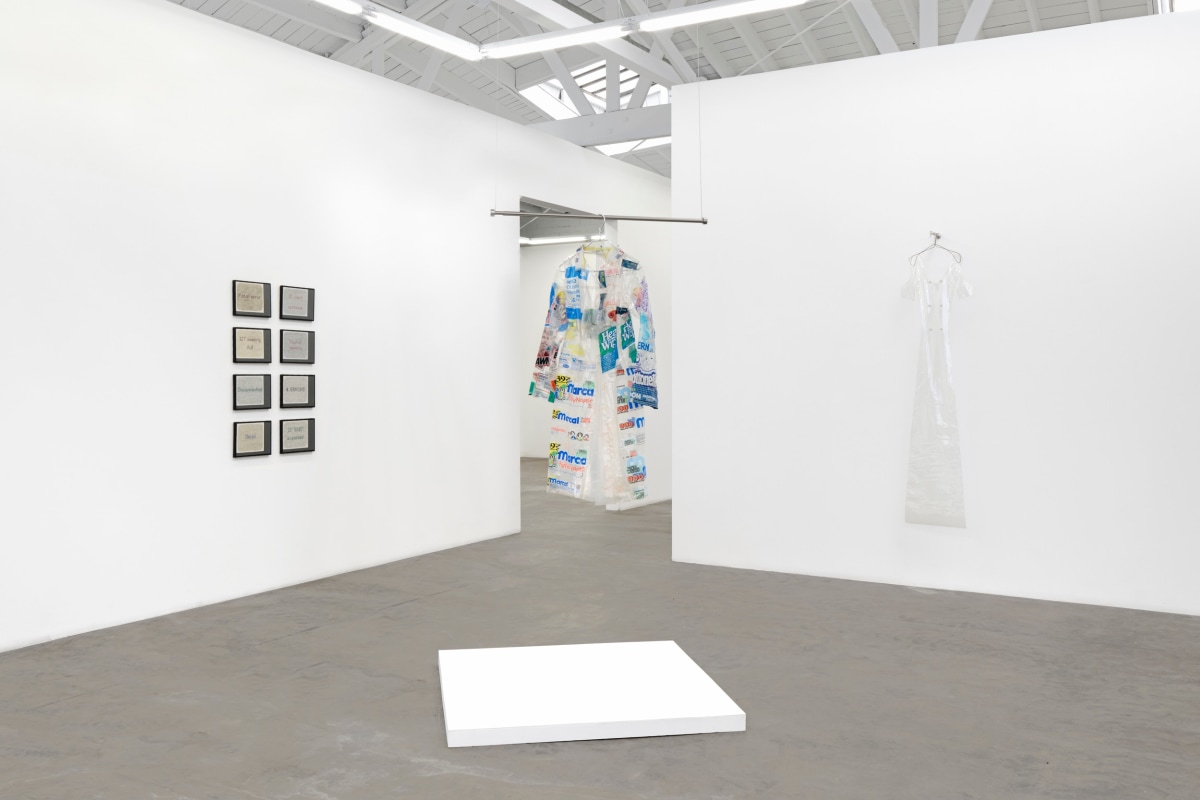
Installation view of Mimi Smith, Head-On
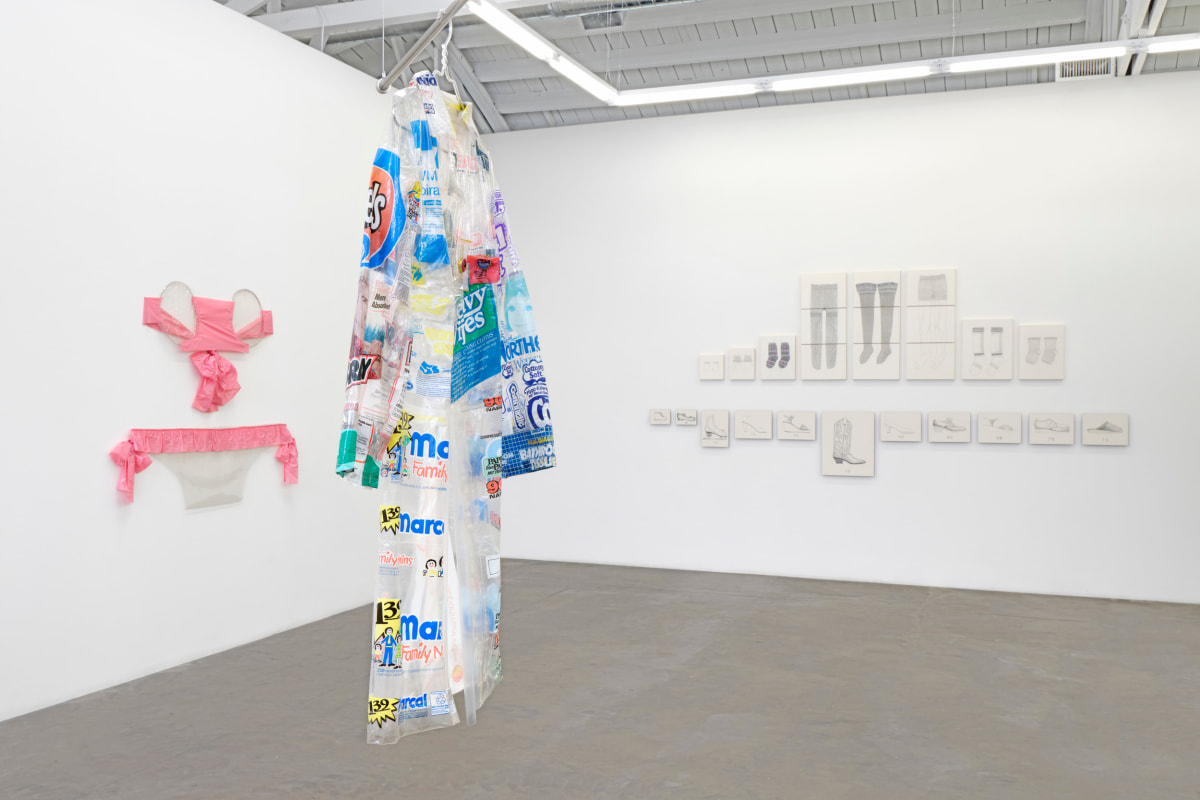
Installation view of Mimi Smith, Head-On
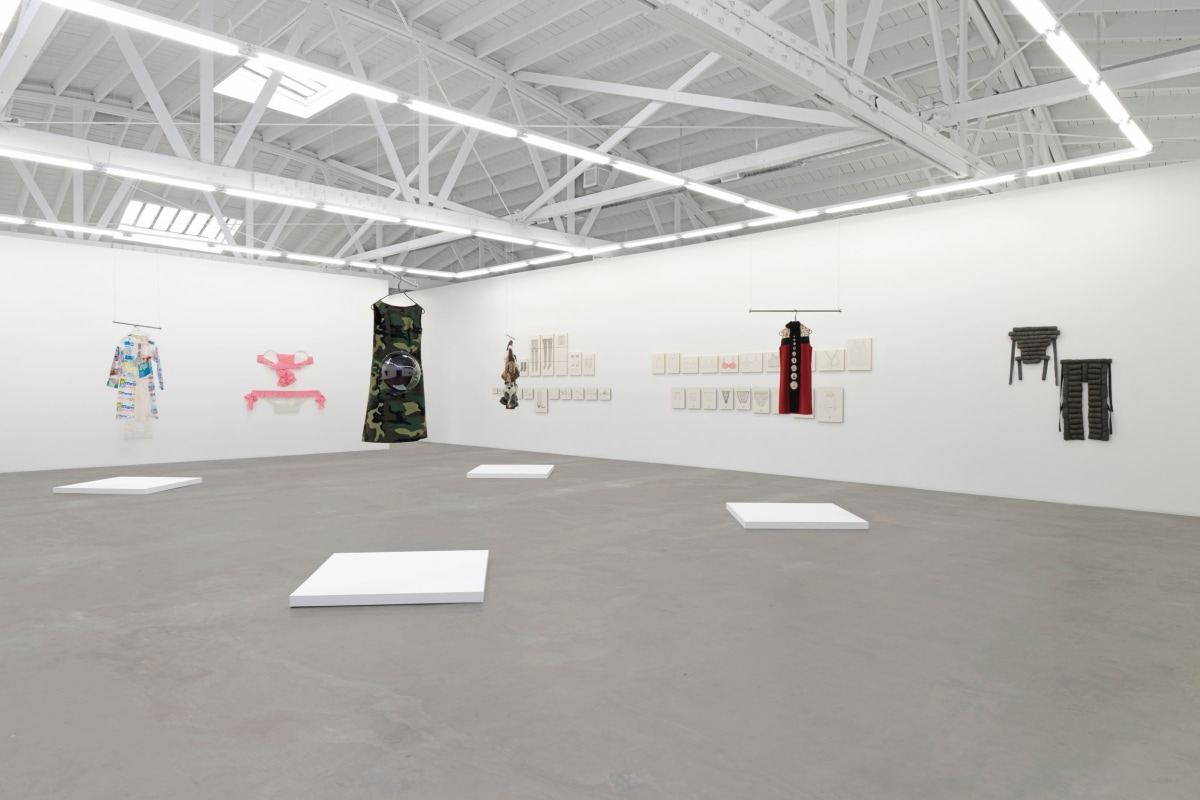
Installation view of Mimi Smith, Head-On
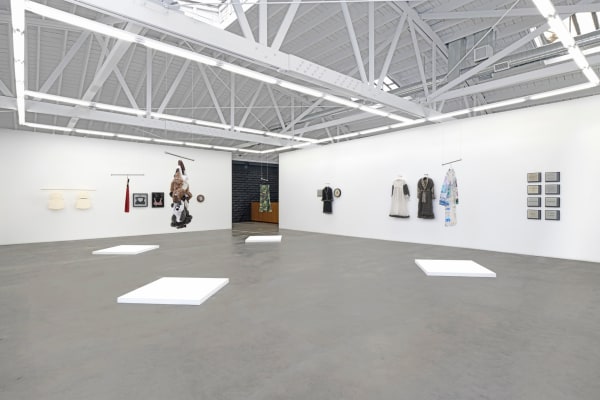
Installation view of Mimi Smith, Head-On
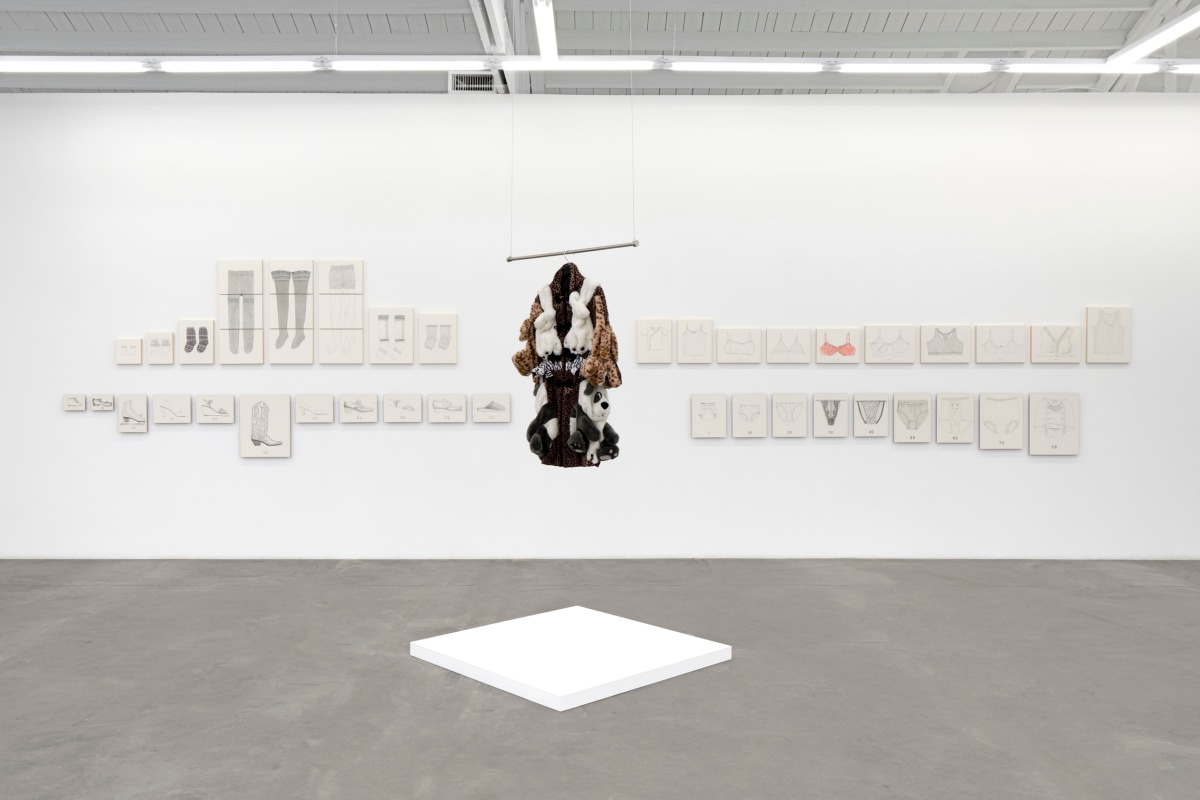
Installation view of Mimi Smith, Head-On
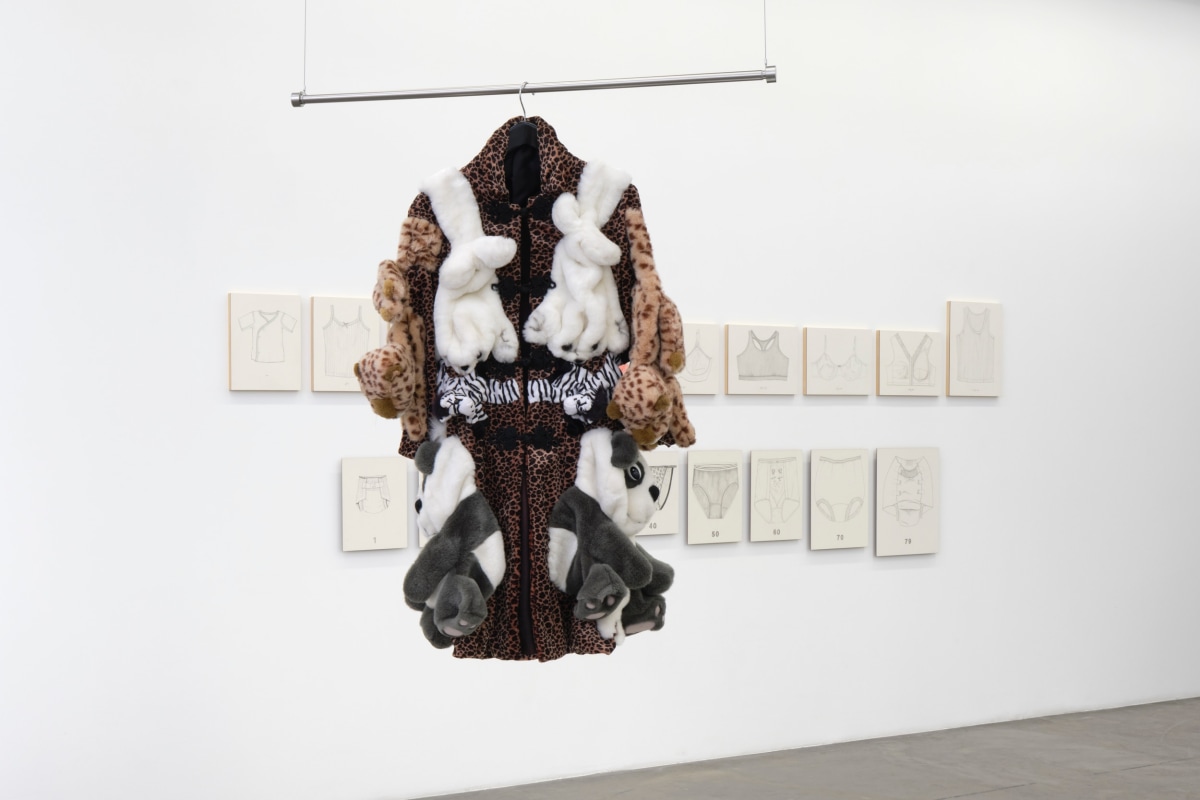
Installation view of Mimi Smith, Head-On
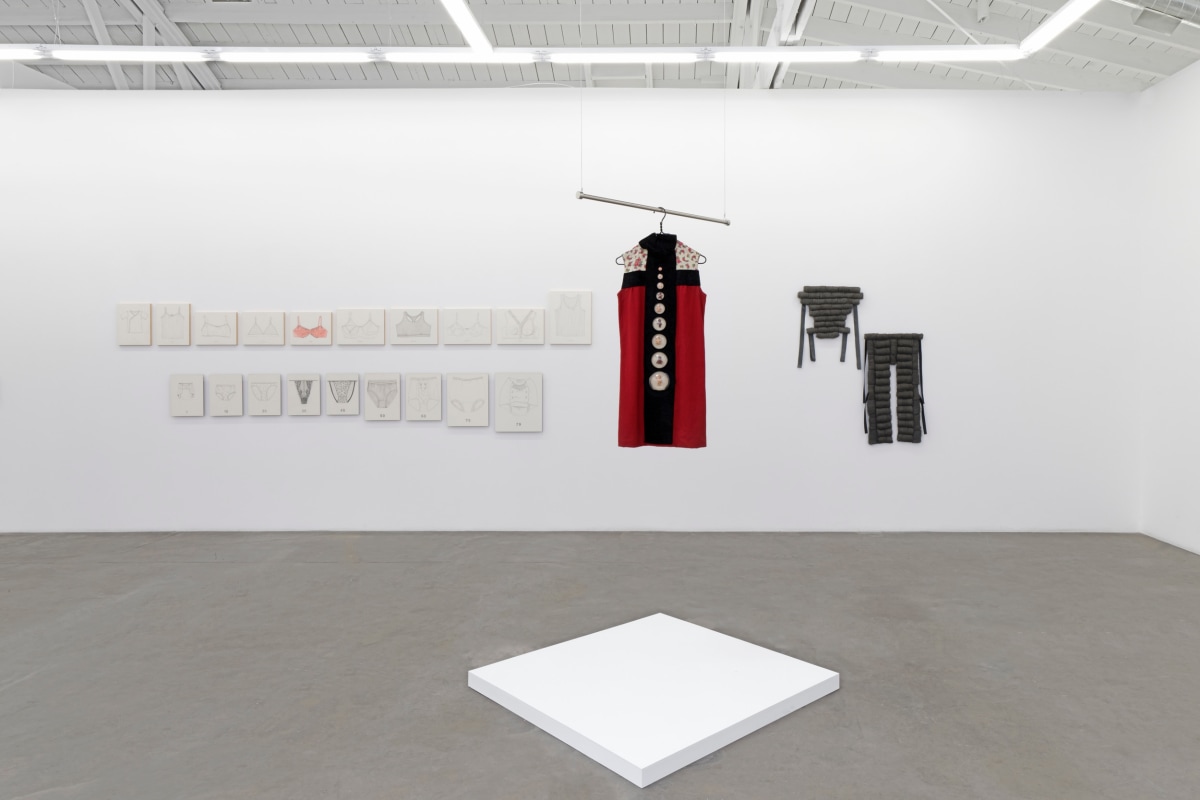
Installation view of Mimi Smith, Head-On
Installation view of Mimi Smith, Head-On
Installation view of Mimi Smith, Head-On
Although my earliest work was also feminist in both a personal and political sense there was no available vocabulary for it and it often went misunderstood, or in some cases not seen for decades. The word “feminism” was not a word in my own vocabulary until the early 70’s when its ideas inspired me with hopes and ambitions for things I had not imagined or even considered. – Mimi Smith, 2017
Luis De Jesus Los Angeles is very pleased to announce MIMI SMITH: HEAD-ON, the pioneering artist’s first solo exhibition on the West Coast, to be presented in Gallery 1 from January 14 through March 4, 2023. An opening reception will be held on Saturday, January 21, from 4 to 7 pm. The exhibition will present sculptures, paintings, and drawings spanning the 1960s to the present.
For nearly six decades, artist Mimi Smith (b. 1942) has created objects that simultaneously engage the personal, domestic sphere and the larger socio-political context of our time. Smith is often regarded as a feminist artist avant la lettre—ahead of her time—creating work that forecasted the Feminist Art Movement of the 1970s. The works presented in this exhibition are indicative of Smith’s experimentation with various mediums in navigating to womanhood, identity and history, and use her body as “the armature for a worn environment.”
While studying at Rutgers University in the early/mid-1960s, Smith’s artistic practice flourished as she began experimenting with hand-sewn clothing garments as sculptural objects. Rutgers, recent home to Allen Kaprow and Roy Lichtenstein, is where Smith studied with Fluxus and Conceptual artist Robert Watts and Minimalist sculptor Robert Morris, who encouraged her to take on non-traditional art materials. She embraced the Rutgers ethos of “anything is possible” and began incorporating fabric into her abstract works.
By the completion of her MFA degree in 1966, Smith utilized clothing as both content and form. She came into her own during this time, just as the notion of the proximity of art and life was gaining momentum. While her work carries affinities to both Pop and New Realism (though none of the consumerism and spectacle of the former or the defiant violence of the latter), it subverts and exists outside the bounds of popular art movements of the time. Her artistic production was autobiographical and intimate at a time when formalism still dictated that art should not be emotional or personal.
Smith’s clothing sculpture from this period, a number of which are included in this exhibition, is engaged with social and cultural critique through appropriating materials from the domestic space. She saw that articles of clothing carry complex layers of meaning and experience. Understanding the gendered implications of clothing, her objects were accessible in that “girls especially, but even men, had more experience looking at clothes than they did looking at art.” Her talent for sewing and making dresses allowed her to “communicate the shared experience of being female in society.”
In 1965, Smith created Model Dress, a disproportionately, attenuated dress made of plastic, buttons and a metal hanger. This work critiques societal expectations that pressure women to reshape and suffocate their bodies to appeal to a rather exclusive body standard. Bikini (1965) explores similar ideas about womenswear through playing with scale. Another notable work, Biography (1996)—based on Steel Wool Peignoir (1966)—combines nylon, satin, and lace (common to the negligee, or dressing gown) with steel wool and juxtaposes the romantic association and airiness of the garment with the harsher reality of marriage and domestic responsibilities. The work investigates what Nancy Spector called the “psychosexual dimensions” of a garment like the peignoir and concepts of a protective armor. Smith noted she felt that Steel Wool Peignoir “combined the reality of my life with the romance of what I thought it would be.”
During the 1980s, 90s and early 2000s, Smith expanded her practice, creating sculptures, paintings, and performances as a form of social commentary—in response to war, ecology and the environment, abortion, AIDS, work, and other issues in relation to womanhood. Smith’s Camouflage Maternity Dress (2004) is a re-imagining of Maternity Dress (1966). In both sculptures, the dress features a transparent plastic dome that reveals the maternal bump (she wore the mod 60s version with its faux-marble kitchen linoleum pattern during her first pregnancy). In Camouflage Maternity Dress, the plastic pod is posed in contrast to a bold battledress pattern, challenging expectations of women who go great lengths to conceal a growing baby while experiencing the realities of pregnancy and motherhood. Here, Smith reveals the process of reproduction and birth as being a war-like experience.
In response to the growing number of women climbing the corporate ladder, Smith created the installation Slave Ready: Corporate (1991-1993) featuring a “dress for success" grey pinstripe suit edged in steel wool. To the right of the suit a wall clock reads “Just a Minute, Please,” and on the left side, a computer Error Message painting exclaims “Slave Ready.” In the 1980s, Smith learned computer programming which inspired a series of 9 x 12-inch paintings of computer error messages. This series relies on the "master-slave" computer user language which was highly coded for inaccessibility. (Today, there is a push for more neutral, less offensive terms.)
Another work in the exhibition, Endangered Species Coat (2007), is an ironic response to how clothing is used as a protective guard against harsh environmental conditions yet is constructed of (plush) endangered animals that have suffered at the expense of human consumption. A common theme that threads her works together is how clothing acts as an extension of personhood, revealing real-life implications without a physical body being present.
Smith’s practice is not just limited to the manipulation of clothing, but also includes a variety of other mediums. She uses graphite and acrylic on board in her series Timelines (1999-2005) to track unseen aspects of the aging process in a systematic way, narrating the cycle of life through the transformation of what is worn overtime. In the Underpants and Undershirts series, a woman’s life is depicted chronologically through illustrations of intimate apparel. The drawings reveal the stages of a life from childhood through old age—from jogging and nursing bras to mastectomy bras—and explore how objects, specifically garments, are signifiers of the complex phases of life. Her sculptural clock, Don't Turn Back (1985) employs words and phrases to address the timely issue of reproductive rights. Don't turn back the hands of time; protect women's right to choose.
Smith’s work remains as fresh and pointed today as it was when she created it. By employing accessible materials and personal narrative, her works raise questions that go far beyond the usual concerns of “art.” She was prescient in her practice rooted in feminist criticism by critiquing the coded, subtle messages within the seemingly innocuous objects and events of everyday life. Mimi Smith’s works expand beyond feminist issues, interrogating contemporary politics, media and the language of art itself.
Mimi Smith (b. 1942, Brookline, MA) received her MFA from Rutgers University in 1966 and her BFA from Massachusetts College of Art in 1963. Her work was included in the seminal exhibition WACK! Art and the Feminist Revolution (2007), curated by Connie Butler, and has been exhibited extensively throughout the United States, and internationally at such institutions as the New Museum, New York; The Museum of Modern Art, New York; Walker Art Center, Minneapolis; Harvard Art Museums, Cambridge, MA; Fine Arts Museums of San Francisco; Rhode Island School of Design, Providence; The Bronx Museum, NY; Hayward Gallery, London; and The Institute of Contemporary Art, Tokyo, among others. Smith has been awarded a Joan Mitchell Grant, a New York Foundation of the Arts Fellowship, and a National Endowment for the Arts Fellowship Grant. Smith’s works are in the collection of the Museum of Modern Art, New York; The Getty, Los Angeles; Spencer Museum of Art, Lawrence, KS; Fogg Art Museum, Harvard Art Museums, Cambridge, MA; The Museum of Art, Rhode Island School of Design, Providence, RI; The Institute of Contemporary Art, Tokyo, among others. Smith lives and works in New York City.
For further information, including images and previews, please call 213-395-0762, or email: gallery@luisdejesus.com.
